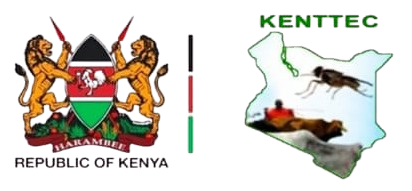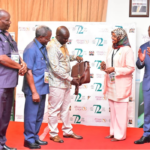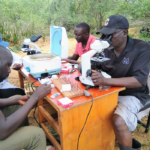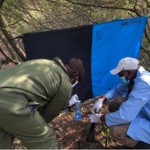The history of tsetse control in Kenya dates back to over 100 years. Past attempts through a number of control programs have had varied levels of success. However, lack of sustained control has ensured the re-invasion of T&T controlled areas. During the previous Strategic Plan, cycle the KENTTEC had focused on area-wide IPM with utilization of tsetse-freed areas for modern agricultural production. However inadequate funding limited KENTTEC’s success. During the implementation of the 2018-2022 Strategic Plan, KENTTEC will adopt the PCP tool developed by the OIE/FAO/WHO to guide T&T eradication efforts. PCP is premised on staged approaches of reduction, elimination and eradication of a range of human and animal diseases such as Foot-and-Mouth Disease (FMD), Peste Des Petits Ruminants (PPR), brucellosis and rabies. The PCP (see Figure.1) tool provided a systematic framework for planning and evaluating field T&T eradication activities. KENTTEC will adopt county government as a unit of operation and resource mobilization.
The tsetse-infested counties are at different levels of T&T management requiring different interventions to move from one stage to the other in order to achieve elimination. Moreover, there are a number of layers in T&T management operations including KALRO, ICIPE, KWS and ILRI among others. Coordination of this institutions to achieve eradication in the country needs to be strengthened. Other issues include low uptake of T&T control technologies among stakeholders, climate change which affects tsetse distribution, lack of harmonization of tsetse control activities between neighboring countries to address the trans-boundary nature of the tsetse and the disease, weak research-extension linkage, T&T data management and sustainability of gains made in suppression.
Specific objective 1.1: To create tsetse and trypanosomiasis-free areas in Kenya
Strategies
In order to achieve specific objective 1 the following strategies will be adopted:
- Adopt, promote and upscale the uptake of T&T eradication technologies.
- Updating of T&T maps with stakeholders.
- Develop and implement T&T surveillance system.
Specific Objective 1.2: To promote sustainable land use management in tsetse-freed areas
Strategies
In order to achieve specific objective 2 the following strategies will be adopted:
- Enhance sustainable land use technologies in tsetse freed areas.
- Promote agricultural and entrepreneurship activities in freed areas.
- Develop and maintain T&T control barrier systems.
KENTTEC was gazetted as a state corporation in the then Ministry of Livestock Development (MoLD) vide an Executive Order Legal Notice No. 77 of the Kenya Gazette Supplement No.76 of 27th July 2012 under the State Corporation Act (Cap 446). This instrument provides temporary tenure to the institution thus hampering its long-term planning and investment. The eradication and control is guided by Animal Disease Act (Cap 364), Public Health (Cap 242) and the National Livestock Policy of 2008. Other related policies and Acts of Parliament that relate to tsetse control include Pharmacy and Poison Act( Cap 244), Pest Control and Management Act 2013 (Cap 376), Science and Technology Act (Cap 250), Environmental Management Coordination (EMCA) (Cap 387), Kenya National Drug Policy of 1994, and the National Land Policy of 2009.
A perusal of this legal and policy document reveals that they do not adequately address the issue of T&T eradication in Kenya as demonstrated by overlapping and, in some instances, contradicting provisions. Additionally, there is severe overlap in institutional mandate between the Directorate of Veterinary Services (DVS) and the Kenya Agriculture and Livestock Research Organization (KALRO). Kenya therefore urgently needs clear legal, policy and institutional frameworks to adequately guide its T&T eradication campaign.
Specific Objective 2.1: To develop policy institutional and legal framework supportive of T&T eradication
Strategies
In order to achieve specific objective 1 the following strategies will be adopted:
- Develop, advocate and implement T&T regional policy, institutional and legal framework in collaboration with stakeholders
- Develop, advocate and implement T&T national policy, institutional and legal framework in collaboration with stakeholders
- Support the development and implementation of T&T policy, institutional and legal framework in counties
Specific Objective 2.2: To develop and disseminate tsetse control and eradication guidelines.
Strategies
In order to achieve specific objective 2 the following strategies will be adopted:
- Develop and implement regional/ transboundary tsetse control and eradication guidelines
- Develop and disseminate county tsetse control and eradication guidelines
- Develop and implement strategies/ guidelines for conservation areas
KENTTEC is mandated to co-ordinate activities of government departments, agencies and other stakeholders at the national and county levels in matters related to T&T. The Council promotes collaboration among stakeholders, advices the government and its negotiations and other engagements with foreign counties and international organizations in matters relating to T&T eradication. In addition, the Council is expected to negotiate and mobilize resources and promote public and private sector partnership for sustainable T&T eradication.
Specific Objective 3.1: To develop and implement coordination, collaboration and partnerships framework on T&T
Strategies
In order to achieve specific objective 1 the following strategies will be adopted:
- Develop T&T platforms on information sharing and identification and prioritization of T&T intervention areas and programs
- Develop and implement framework on collaboration and partnerships
- Establish coordination mechanisms at national, county and local levels
Specific Objective 3.2: To develop capacity for stakeholders in T&T eradication
Strategies
In order to achieve specific objective 2 the following strategies will be adopted:
- Develop and implement training programs for stakeholders in T&T eradication
- Sensitize and mobilize stakeholders on T&T eradication
- Support stakeholders to mobilize resources for T&T eradication
Specific Objective 4.1: To improve generation of appropriate technologies, innovations, and knowledge through research
Strategies
In order to achieve specific objective 1 the following strategies will be adopted:
- Develop and implement a framework for T&T research coordination and priority setting
- Develop and implement a framework to support research in T&T
- Develop capacity to conduct adaptive research
Specific Objective 4.2: To develop knowledge management system for T&T
Strategies
In order to achieve specific objective 2 the following strategies will be adopted:
- Establish databases and repositories for data and knowledge on T&T
- Package, digitize an disseminate knowledge on T&T
- Develop and implement T&T dissemination pathways
- Develop and implement digital platforms for sharing T&T information among stakeholders
KENTTEC as an organization is faced with various institutional challenges including inadequate staff capacity, office space and funding. The Council currently has 31 officers on deployment from the State Department of Livestock against an identified and already authorized staff establishment of 432 employees.
The only financier of KENTTEC at the moment is the Government of Kenya through the MTEF budgeting process. KENTTEC falls under the State Department of Agricultural Research and Crops in the Ministry of Agriculture, Livestock and Fisheries. The resource requirements for implementation of this Strategic Plan is way beyond the traditional funding levels provided by the exchequer. Its successful implementation therefore calls for KENTTEC to mobilize resources beyond what is provided by the Government. However, due to the trans-boundary nature of tsetse and trypanosomiasis, the Government should consider enhanced budgetary allocation for T&T eradication as a public good.
Owing to inadequate funding from the exchequer, the Council will adopt the following strategies to raise the 7.9 billion shillings required to implement this Strategic Plan:
- Mobilize at least 70% (i.e., KShs 5.53 billion) of the total budget through the MTEF
- Because agriculture and livestock production are a devolved function, KENTTEC will work in collaboration with county governments and have them contribute resources for T&T eradication. This is expected to raise at least 5% (i.e., KShs 395 million) of the total budget.
- Funding from development partners to cater for at least 20% (i.e., Kshs 1.58 billion) of the total budget. Target donors include but not limited to: Food and Agricultural Organization (FAO), World Bank (WB), AfDB, European Union (EU), AU and United States Agency for international development (USAID), BADEA
- Funds from collaborating to account for 5% (i.e., Kshs 395 million) of the total budget. Target institutions include but not limited to: FAO, KWS, KALRO, International Livestock Research Institute (ILRI), International Centre of Insects Physiology and Ecology (ICIPE), KVA, Ministry of Health and Universities.
- KENTTEC headquarters is housed in a rented premises which incurs high recurrent costs. Regional offices are housed at respective county offices. There is therefore need to acquire land in an appropriate location for the construction of KENTTEC headquarters with staff houses and regional offices. This will save on rental expenses.
Specific Objective 5.1: To enhance human resource capacity strategies
Strategies
In order to achieve specific objective 1 the following strategies will be adopted:
- Improve employee planning and staff development for optimal workforce requirement and succession.
- Develop and implement human resource policies and documentation.
- Establish and implement an integrated human resource information management systems (HRIS)
Specific Objective 5.2: To mobilize resources for T&T eradication
Strategies
In order to achieve specific objective 2 the following strategies will be adopted:
- Strengthen mobilization of resources from national and county governments and development partners
- Strengthen internal revenue generation
- Strengthen financial resource management system
Specific Objective 5.3: To develop T&T eradication infrastructure
Strategies
In order to achieve specific objective 3 the following strategies will be adopted:
- Plan and construct KENTTEC headquarters and regional centres
- Plan and acquire equoment for T&T eradication
- Develop and implement proposals for accessing infrastructure for T&T eradication.
Specific Objective 5.4: To develop ICT system
Strategies
In order to achieve specific objective 4 the following strategies will be adopted:
- Establish, operationalize and maintain ICT infrastructure
- Develop and implement data integration and analytical tools
- Develop and implement ICT policy
Specific Objective 5.5: To enhance emergency preparedness
Strategies
In order to achieve specific objective 5 the following strategies will be adopted:
- Improve safety in the work environment.
- Develop and implement corporate contingency plan
In compliance to Chapter six of the Constitution of Kenya (2010) on leadership and integrity, cognizance of the Mwongozo Code of Conduct, the Council will put in place measures to ensure that its staff and stakeholders adhere to principals set out in this chapter. The Council will integrate Article 10 on national values and principles of governance in all its activities.
Specific Objective 6.1: To strengthen corporate governance and promote national values
Strategies
In order to achieve specific objective 1 the following strategies will be adopted:
- Strengthen corporate governance
- Promote national cohesion and values
- Sensitization in training of staff on governance
Specific Objective 6.2: To strengthen corporate image
Strategies
In order to achieve specific objective 2 the following strategies will be adopted:
- Develop and implement policy on branding
- Develop and implement policy on corporate social responsibility
- Sensitize customers on KENTTEC programs







